Camshaft
|
1. |
Measure the height of the cam lobe using a micrometer and check
the surface of the cam lob for wear and tear. If necessary, replace
the camshaft.
Cam height
Intake : 44.15 mm (1.738 in.)
Exhaust : 43.55 mm (1.715 in.)
|
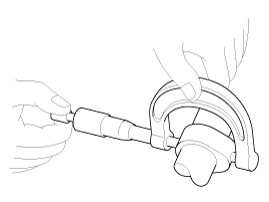
|
|
2. |
Check the surface of the camshaft journal for wear and tear. If
the camshaft journal is excessively damaged, replace the camshaft.
|
|
3. |
Inspect the camshaft journal clearance.
|
(1) |
Clean the camshaft journals and bearing caps.
|
|
(2) |
Place the camshafts in the cylinder head.
|
|
(3) |
Lay a strip of plastigauge across each of the camshaft
journals.
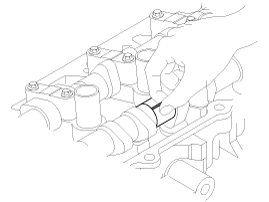
|
|
(4) |
Install the bearing caps and tighten the bolts to the
specified torque.
Tightening torque
1st step
M6 bolt : 5.9 N.m (0.6 kgf.m, 4.3 lb-ft)
M8 bolt : 9.8 N.m (1.0 kgf.m, 7.2 lb-ft)
2nd step
M6 bolts :
11.8 ~ 13.7N.m (1.2 ~ 1.4kgf.m, 8.7 ~ 10.1lb-ft)
M8 bolts :
18.6 ~ 22.6N.m (1.9 ~ 2.3kgf.m, 13.7 ~ 16.6lb-ft)
|
|
Do not turn the camshaft.
|
|
|
(5) |
Remove the bearing caps.
|
|
(6) |
Measure the plastigauge at the widest point. If the clearance
is greater than the specification, replace the camshaft. If
necessary, replace the bearing caps and the cylinder head as
a set.
Camshaft bearing cap
oil clearance
Standard :
0.027 ~ 0.058 mm (0.0011 ~ 0.0023 in.)
Limit : 0.1 mm (0.0039 in.)
|
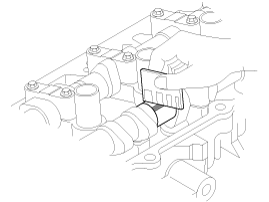
|
|
|
4. |
Inspect the camshaft end play.
|
(1) |
Inspect the camshaft end play.
|
|
(2) |
Measure the end play while moving the camshaft back and
forth using a dial gauge. If the end play is greater than the
specification, replace the camshaft. If necessary, replace the
bearing caps and the cylinder head as a set.
Camshaft end play
Standard : 0.1 ~ 0.2 mm (0.0039 ~ 0.0079 in.)
|
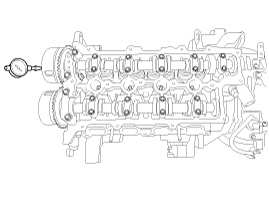
|
|
(3) |
Remove the camshafts.
|
|
CVVT (Continuously Variable Valve Timing) Assembly
|
1. |
Inspect the CVVT for smooth rotation.
|
(1) |
Clamp the camshaft using a vise. Be careful not to damage
the cam lobes and journals in the vise.
|
|
(2) |
Check that the CVVT is locked by turning it clockwise
or counterclockwise. It must not rotate.
|
|
(3) |
Intake CVVT : Seal one of the two advance holes in the
camshaft journal with tape.
Exhaust CVVT : Seal one of the two retard holes in the
camshaft journal with tape.
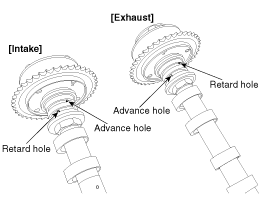
|
|
(4) |
Intake CVVT : Apply approx. 150 kPa (1.5 kgf/cm², 21 psi
) of compressed air into the unsealed advance hole to release
the lock.
Exhaust CVVT : Apply approx. 150 kPa (1.5 kgf/cm², 21
psi ) of compressed air into the unsealed retard hole to release
the lock.
|
Cover the oil paths with a piece of cloth when
applying compressed air to prevent oil from spraying.
|
|
|
(5) |
Intake CVVT : With compressed air applied, rotate the
CVVT into the advance direction (counterclockwise) within its
phasing range and check that the CVVT turns smoothly.
Exhaust CVVT : With compressed air applied, rotate the
CVVT into the retard direction (clockwise) and check that the
CVVT turns smoothly.
CVVT phasing range
Intake : 25°±1° (from the most retarded position
to the most advanced position)
Exhaust : 20°±1° (from the most advanced position
to the most retarded position)
|
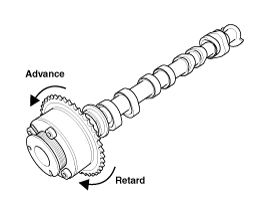
|
|
(6) |
Intake CVVT : Rotate the CVVT into the most retarded position
(clockwise) and then check that the CVVT is locked.
Exhaust CVVT : Rotate the CVVT into the most advanced
position (counterclockwise) and then check that the CVVT is
locked.
|
|
1.
Remove the cylinder head cover.
(Refer to Cylinder Head Assembly - "Cylinder Head Cover")
2.
Turn the crankshaft damper pu ...
1.
Install the intake CVVT (A) to the intake camshaft.
Tightening torque :
63.7 ~ 73.5 N.m (6.5 ~ 7.5 kgf.m, 47.0 ~ 54.2 lb-ft)
...
 Kia Soul: CVVT & Camshaft Inspection
Kia Soul: CVVT & Camshaft Inspection CVVT & Camshaft Removal
CVVT & Camshaft Removal CVVT & Camshaft Installation
CVVT & Camshaft Installation







